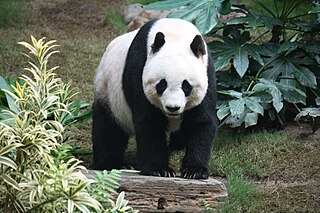
The giant panda, also known as the panda bear or simply panda, is a bear species endemic to China. It is characterised by its black-and-white coat and rotund body. The name "giant panda" is sometimes used to distinguish it from the red panda, a neighboring musteloid. Adult individuals average 100 to 115 kg, and are typically 1.2 to 1.9 m long. The species is sexually dimorphic, as males are typically 10 to 20% larger. The fur is white, with black patches around the eyes, ears, legs and shoulders. A thumb is visible on the bear's forepaw, which helps in holding bamboo in place for feeding. Giant pandas have adapted larger molars and expanded temporal fossa to meet their dietary requirements.
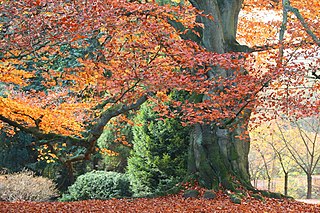
Beech (Fagus) is a genus of deciduous trees in the family Fagaceae, native to temperate Eurasia and North America. There are 13 accepted species in two distinct subgenera, Engleriana and Fagus. The subgenus Engleriana is found only in East Asia, distinctive for its low branches, often made up of several major trunks with yellowish bark. The better known Fagus subgenus beeches are native to Europe and North America. They are high-branching trees with tall, stout trunks and smooth silver-grey bark. The European beech Fagus sylvatica is the most commonly cultivated species, yielding a utility timber used for furniture construction, flooring and engineering purposes, in plywood, and household items. The timber can be used to build homes. Beechwood makes excellent firewood. Slats of washed beech wood are spread around the bottom of fermentation tanks for Budweiser beer. Beech logs are burned to dry the malt used in some German smoked beers. Beech is also used to smoke Westphalian ham, andouille sausage, and some cheeses.

Allium ursinum, known as wild garlic, ramsons, cowleekes, cows's leek, cowleek, buckrams, broad-leaved garlic, wood garlic, bear leek, Eurasian wild garlic or bear's garlic, is a bulbous perennial flowering plant in the amaryllis family Amaryllidaceae. It is native to Europe and Asia, where it grows in moist woodland. It is a wild relative of onion and garlic, all belonging to the same genus, Allium. There are two recognized subspecies: A. ursinum subsp. ursinum and A. ursinum subsp. ucrainicum.

Fistulina hepatica, commonly known as the beefsteak fungus, beefsteak polypore, poor man’s steak, ox tongue, or tongue mushroom, is an unusual bracket fungus classified in the Agaricales, that is commonly seen in Britain and the rest of Europe, but which can be found in North America, Australia, North Africa, and Southern Africa. As its name suggests, it looks remarkably similar to a slab of raw meat. It has been used as a meat substitute in the past, and can still be found in some French markets. It has a sour, slightly acidic taste. For eating, it must be collected young and it may be tough and need to be cooked for a long time.

Pleurotus ostreatus, the oyster mushroom, oyster fungus, hiratake, or pearl oyster mushroom is a common edible mushroom. It is one of the more commonly sought wild mushrooms, though it can also be cultivated on straw and other media.

Cancer pagurus, commonly known as the edible crab or brown crab, is a species of crab found in the North Sea, North Atlantic Ocean, and perhaps the Mediterranean Sea. It is a robust crab of a reddish-brown colour, having an oval carapace with a characteristic "pie crust" edge and black tips to the claws. A mature adult may have a carapace width up to 25 centimetres and weigh up to 3 kilograms. C. pagurus is a nocturnal predator, targeting a range of molluscs and crustaceans. It is the subject of the largest crab fishery in Western Europe, centred on the coasts of the British Isles, with more than 60,000 tonnes caught annually.

Hydnum repandum, commonly known as the sweet tooth, pig's trotter, wood hedgehog or hedgehog mushroom, is a basidiomycete fungus of the family Hydnaceae. First described by Carl Linnaeus in 1753, it is the type species of the genus Hydnum. The fungus produces fruit bodies (mushrooms) that are characterized by their spore-bearing structures—in the form of spines rather than gills—which hang down from the underside of the cap. The cap is dry, colored yellow to light orange to brown, and often develops an irregular shape, especially when it has grown closely crowded with adjacent fruit bodies. The mushroom tissue is white with a pleasant odor and a spicy or bitter taste. All parts of the mushroom stain orange with age or when bruised.

Oemleria cerasiformis, a shrub commonly known as osoberry or Indian plum, is the sole species in genus Oemleria.

Cortinarius caperatus is an edible mushroom of the genus Cortinarius found in northern regions of Europe and North America. It was known as Rozites caperata for many years before genetic studies revealed that it belonged to the genus Cortinarius. The fruit bodies appear in autumn in coniferous and beech woods as well as heathlands in late summer and autumn. The ochre-coloured cap is up to 10 cm (4 in) across and has a fibrous surface. The clay-colored gills are attached to the stipe under the cap, and the stipe is whitish with a whitish ring. The Latin specific name, caperatus, means wrinkled, and refers to the distinctive texture of the cap. The flesh has a mild smell and flavor.
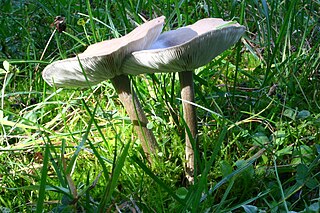
Melanoleuca is a poorly known genus of saprotrophic mushrooms traditionally classified in the family Tricholomataceae. Most are small to medium sized, white, brown, ocher or gray with a cylindrical to subcylindrical stipe and white to pale yellowish gills. The basidiospores are ellipsoid and ornamented with amyloid warts. Melanoleuca is considered a difficult group to study due to their macroscopic similarities among species and the need of a thorough microscopic analysis to separate species. DNA studies have determined that this genus is closely related to Amanita and Pluteus and that it does not belong to the family Tricholomataceae.
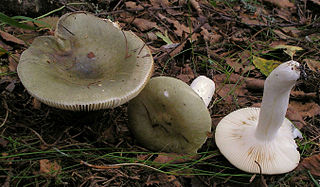
Russula aeruginea, also known as the grass-green russula, the tacky green russula, or the green russula, is an edible Russula mushroom. Widely distributed in northern temperate regions, it is usually found under birch, mostly in pine forests. The very poisonous death cap can have a similar appearance, especially from above.

Musa acuminata is a species of banana native to Southern Asia, its range comprising the Indian Subcontinent and Southeast Asia. Many of the modern edible dessert bananas are from this species, although some are hybrids with Musa balbisiana. First cultivated by humans around 10 kya, it is one of the early examples of domesticated plants.
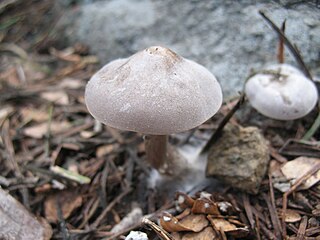
Clitocybe glacialis is a species of mushroom in the family Tricholomataceae. Formerly known as Lyophyllum montanum, this is a snowbank mushroom, always associated with melting snow along snowbanks and thus glacialis. Originally described by Alexander H. Smith in 1957, this North American species is typically found growing under conifers on mountains.

The forest cobra, also commonly called the black cobra and the black and white-lipped cobra, is a species of highly venomous snake in the family Elapidae. The species is native to Africa, mostly the central and western parts of the continent. It is the largest true cobra species with a record length of 3.2 metres.

Prunus avium, commonly called wild cherry, sweet cherry or gean is a species of cherry, a flowering plant in the rose family, Rosaceae. It is native to Europe, Anatolia, Maghreb, and Western Asia, from the British Isles south to Morocco and Tunisia, north to the Trondheimsfjord region in Norway and east to the Caucasus and northern Iran, with a small isolated population in the western Himalaya. The species is widely cultivated in other regions and has become naturalized in North America, New Zealand and Australia.

Amanita ceciliae, commonly called snakeskin grisette, strangulated amanita, and the Cecilia's ringless amanita, is a basidiomycete fungus in the genus Amanita. First described in 1854 by Miles Joseph Berkeley and Christopher Edmund Broome, it was given its current name by Cornelis Bas in 1984. It is characterized by bearing a large fruit body with a brown cap 5–12 cm (2.0–4.7 in) across. The cap has charcoal-grey patches, which are easily removable. The stipe is 7–18 cm (2.8–7.1 in) long, white in colour, and there is no ring on it. It is slightly tapered to the top, and has irregular cottony bands girdling the base. The universal veil is grey. Spores are white, spherical in shape, non-amyloid, and measure 10.2–11.7 micrometres. The mushrooms are considered edible, but field guides typically advise caution in selecting them for consumption, due to risks of confusion with similar toxic species. A. ceciliae is found in woods throughout Europe and North America, where it fruits during summer and autumn.

Melanoleuca melaleuca is a species of mushroom in the family Tricholomataceae, and it is the type species of its genus Melanoleuca. It is difficult to distinguish from other related species firstly because it is variable, secondly because the taxonomic criteria are often based on characteristics which have later been found to be variable, and thirdly because there is much disagreement between authorities as to exactly how the species should be defined.

Sambucus cerulea or Sambucus nigra ssp. cerulea, with the common names blue elderberry and blue elder, is a coarse textured shrub species of elder in the family Adoxaceae.

Auricularia auricula-judae, commonly known as wood ear, jelly ear, or more historically, Jew's ear, is a species of fungus in the order Auriculariales. Basidiocarps are brown, gelatinous, and have a noticeably ear-like shape. They grow on wood, especially elder. The specific epithet is derived from the belief that Judas Iscariot hanged himself from an elder tree.

Melanoleuca cognata, commonly known as the spring cavalier, is an edible species of agaric fungus. It is found in Europe and North America in forests, meadows, and parks. The species may be difficult to identify without analysis of its microscopic features.




















